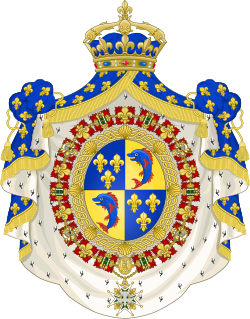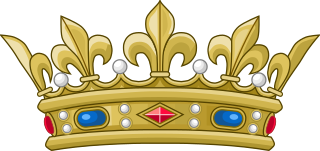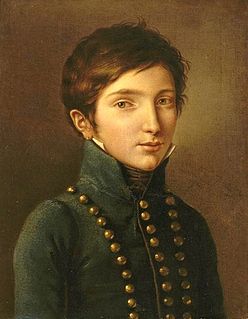
Louis Napoléon Bonaparte was a younger brother of Napoleon I, Emperor of the French. He was a monarch in his own right from 1806 to 1810, ruling over the Kingdom of Holland. In that capacity he was known as Louis I.

Louis XVII was the younger son of King Louis XVI of France and Queen Marie Antoinette. His older brother, Louis Joseph, Dauphin of France, died in June 1789, a little over a month before the start of the French Revolution. At his brother's death he became the new Dauphin, a title he held until 1791, when the new constitution accorded the heir apparent the style of Prince Royal.

Louis XVIII, known as the Desired, was King of France from 1814 to 1824, except for the Hundred Days in 1815. He spent twenty-three years in exile: during the French Revolution and the First French Empire (1791–1814), and during the Hundred Days.

Charles X was King of France from 16 September 1824 until 2 August 1830. An uncle of the uncrowned Louis XVII and younger brother to reigning kings Louis XVI and Louis XVIII, he supported the latter in exile. After the Bourbon Restoration in 1814, Charles became the leader of the ultra-royalists, a radical monarchist faction within the French court that affirmed rule by divine right and opposed the concessions towards liberals and guarantees of civil liberties granted by the Charter of 1814. Charles gained influence within the French court after the assassination of his son Charles Ferdinand, Duke of Berry, in 1820 and eventually succeeded his brother in 1824.

Hortense Eugénie Cécile Bonaparte, Queen consort of Holland, was the stepdaughter of Emperor Napoléon I, being the daughter of his first wife, Joséphine de Beauharnais. Hortense later married Napoléon I’s brother, Louis Bonaparte, who has been made King of Holland, making her the sister-in-law to her step-father. She was the mother of Napoléon III, Emperor of the French; Louis II of Holland; and Napoléon Louis Charles Bonaparte who died at the age of four. She had also an illegitimate son, Charle, Duke of Morny, by her lover, the Comte de Flahaut.

Dauphin of France, originally Dauphin of Viennois, was the title given to the heir apparent to the throne of France from 1350 to 1791 and 1824 to 1830. The word dauphin is French for dolphin. At first the heirs were granted the County of Viennois (Dauphiné) to rule, but eventually only the title was granted.

Duke of Orléans was a French royal title usually granted by the King of France to one of his close relatives, or otherwise inherited through the male line. First created in 1344 by King Philip VI for his younger son Philip, the title was recreated by King Charles VI for his younger brother Louis, who passed the title on to his son and then to his grandson, the latter becoming King Louis XII. The title was created and recreated six times in total, until 1661, when Louis XIV bestowed it upon his younger brother Philippe, who passed it on to his male descendants, who became known as the "Orléans branch" of the Bourbons.

Louise-Élisabeth de Croÿ de Tourzel 11 June 1749 – 15 May 1832), the Marquise de Tourzel was a French noble and courtier. She was the Governess of the Children of France from 1789 until 1792. Decades after the French Revolution, de Tourzel published widely read memoirs, which presented a unique perspective on the royal family.

Marie-Thérèse Charlotte of France, Madame Royale, was the eldest child of Louis XVI and Marie Antoinette, and the only one to reach adulthood. She was married to Louis Antoine, Duke of Angoulême, who was the eldest son of the future Charles X, her father's younger brother; thus the bride and groom were also first cousins.

Baron François Joseph Bosio was a Monegasque sculptor who achieved distinction in the first quarter of the nineteenth century with his work for Napoleon and for the restored French monarchy.

Louis Antoine of France, Duke of Angoulême was the elder son of Charles X of France and the last Dauphin of France from 1824 to 1830. He was technically King of France and Navarre for less than 20 minutes before he himself abdicated, due to his father's abdication during the July Revolution in 1830. He never reigned over the country, but after his father's death in 1836, he was the legitimist pretender as Louis XIX.

Hortense Mancini, Duchesse de Mazarin, was a niece of Cardinal Mazarin, chief minister of France, and a mistress of Charles II, King of England, Scotland, and Ireland. She was the fourth of the five famous Mancini sisters, who, along with two of their female Martinozzi cousins, were known at the court of King Louis XIV of France as the Mazarinettes.

Louis, Dauphin of France was the elder and only surviving son of King Louis XV of France and his wife, Queen Marie Leszczyńska. He had a younger brother, Philippe, who died as a toddler. As a son of the king, Louis was a fils de France. As heir apparent, he became Dauphin of France. However, he died before ascending the throne. Three of his sons became kings of France: Louis XVI, Louis XVIII and Charles X (1824–1830), a feat only shared - in French royalty - by kings Henry II and Philippe IV.

Fils de France was the style and rank held by the sons of the kings and dauphins of France. A daughter was known as a fille de France.

Charles of France, Duke of Berry, was a grandson of Louis XIV of France. Although he was only a grandson of Louis XIV, Berry held the rank of fils de France, rather than petit-fils de France, as the son of the Dauphin, heir apparent to the throne. The Duke of Berry was for seven years heir presumptive to the throne of Spain (1700–1707), until his brother Philip V fathered a son in 1707.

Napoléon-Louis Bonaparte was King of Holland for less than two weeks in July 1810 as Louis II. He was a son of King Louis I and Queen Hortense. His father was the younger brother of Napoléon I, Emperor of the French, and ruled Holland from 1806 to 1810. His mother was the daughter of Josephine de Beauharnais, Napoléon's first wife. His younger brother, Louis-Napoléon, became Emperor of the French as Napoléon III.
A Colonel General was an officer of the French army during the Ancien Régime, the French Revolution, the Napoleonic era and the Bourbon Restoration.

The term House of France refers to the branch of the Capetian dynasty which provided the Kings of France following the election of Hugh Capet. The House of France consists of a number of branches and their sub-branches. Some of its branches have acceded to the Crown, while others remained cadets.

Paul François de Quelen de La Vauguyon or Paul François de Quélen de Stuer de Caussade, duc de La Vauguyon was a French nobleman. He was governor of Cognac, after having been involved in the last campaigns of the Seven Years' War. He wrote a Portrait de feu monseigneur le Dauphin and was menin to the future Louis XVI, one of the Dauphin's sons. A peer of France, brigadier, maréchal de camp, knight of the ordre du Saint-Esprit, he was chosen to be minister plenipotentiary to the Estates General of the Dutch Republic. He later became French ambassador to Spain, knight of the Golden Fleece, temporary minister of foreign affairs in 1789, then minister of the conseil d'État of Louis XVIII in Verona. He was the main intermediary among Louis's agents in France, but became the victim of intrigues. From the Restoration onwards he was lieutenant général and sat in the peerage of France, where he was noted for his moderation. He and his wife had four children, but the Quelen line died out with his children.
In Ancien Régime France, a menin was one of six gentlemen who were particularly attached to the person of the dauphin. They were also known as gentilshommes de la manche. The word originates in the Portuguese word menino (masculine) or menina, meaning boy or girl, where it denoted a young nobleman made a companion to the royal children. The word was used in France for the first time in 1680 when the household of the Grand Dauphin was set up.


















